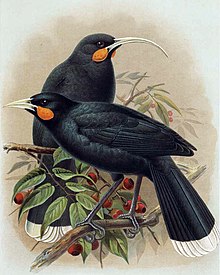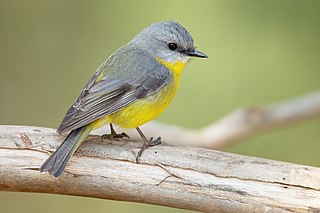
A songbird is a bird belonging to the suborder Passeri of the perching birds (Passeriformes). Another name that is sometimes seen as the scientific or vernacular name is Oscines, from Latin oscen, "songbird". The Passeriformes contains 5,000 or so species found all over the world, in which the vocal organ typically is developed in such a way as to produce a diverse and elaborate bird song.

The New Zealand wrens are a family (Acanthisittidae) of tiny passerines endemic to New Zealand. They were represented by seven Holocene species in four or five genera, although only two species in two genera survive today. They are understood to form a distinct lineage within the passerines, but authorities differ on their assignment to the oscines or suboscines. More recent studies suggest that they form a third, most ancient, suborder Acanthisitti and have no living close relatives at all. They are called "wrens" due to similarities in appearance and behaviour to the true wrens (Troglodytidae) but are not members of that family.
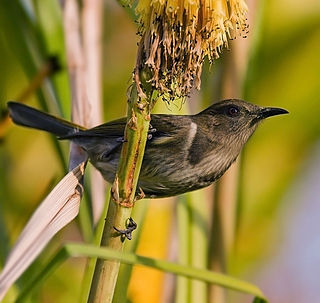
The honeyeaters are a large and diverse family, Meliphagidae, of small to medium-sized birds. The family includes the Australian chats, myzomelas, friarbirds, wattlebirds, miners and melidectes. They are most common in Australia and New Guinea, and found also in New Zealand, the Pacific islands as far east as Samoa and Tonga, and the islands to the north and west of New Guinea known as Wallacea. Bali, on the other side of the Wallace Line, has a single species.
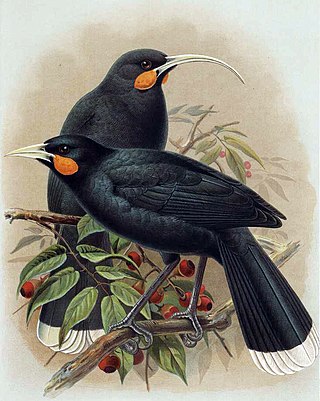
The huia is an extinct species of New Zealand wattlebird, endemic to the North Island of New Zealand. The last confirmed sighting of a huia was in 1907, although there was a credible sighting in 1924.

Tiritiri Matangi Island is located in the Hauraki Gulf of New Zealand, 3.4 km (2.1 mi) east of the Whangaparaoa Peninsula in the North Island and 30 km (19 mi) north east of Auckland. The 2.2 km2 (1 sq mi) island is an open nature reserve managed by the Supporters of Tiritiri Matangi Incorporated, under the supervision of the Department of Conservation and is noted for its bird life, including takahē, North Island kōkako and kiwi. It attracts between 30,000 and 32,000 visitors a year, the latter figure being the maximum allowed by the Auckland Conservation Management Strategy.

Kōkako are two species of forest bird in the genus Callaeas which are endemic to New Zealand, the endangered North Island kōkako and the presumed extinct South Island kōkako. They are both slate-grey with wattles and have black masks. They belong to a family containing five species of New Zealand wattlebirds, the other three being two species of tieke (saddleback) and the extinct huia. Previously widespread, kōkako populations throughout New Zealand have been decimated by the predations of mammalian invasive species such as possums, stoats, cats and rats, and their range has contracted significantly. In the past this bird was called the New Zealand crow. It is not closely related to the crow, but looks like one from a distance.

Conservation in New Zealand has a history associated with both Māori and Europeans. Both groups of people caused a loss of species and both altered their behaviour to a degree after realising their effect on indigenous flora and fauna.

The stitchbird or hihi is a honeyeater-like bird endemic to the North Island and adjacent offshore islands of New Zealand. Its evolutionary relationships have long puzzled ornithologists, but it is now classed as the only member of its own family, the Notiomystidae. It became rare, being extirpated everywhere except Little Barrier Island, but has been reintroduced to two other island sanctuaries and four locations on the North Island mainland.

The South Island piopio also known as the New Zealand thrush, was a passerine bird of the family Oriolidae.
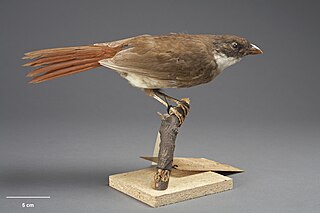
The North Island piopio was a passerine bird of the family Oriolidae. The North Island piopio is now considered to be extinct.

The saddlebacks are two species of New Zealand bird of the family Callaeidae. Both are glossy black with a chestnut saddle. Its taxonomic family is also known as that of the "wattlebirds" and includes the two species of kōkako, as well as the extinct huia. All members of the family Callaeidae have coloured fleshy appendages on either side of the beak, known as wattles; Saddlebacks' wattles are a vivid red.

The Chatham raven is a prehistoric raven formerly native to the Chatham Islands. The closely related New Zealand raven, C. antipodum occurred in the North and South Islands of New Zealand. C. antipodum was formerly included in C. moriorum, and later considered a distinct species, however in 2017 genetic research determined that the two raven populations were subspecies rather than separate species, having only split 130,000 years ago.

A wattle is a fleshy caruncle hanging from various parts of the head or neck in several groups of birds and mammals. Caruncles in birds include those found on the face, wattles, dewlaps, snoods, and earlobes. Wattles are generally paired structures, but may occur as a single structure when it is sometimes known as a dewlap. Wattles are frequently organs of sexual dimorphism. In some birds, caruncles are erectile tissue and may or may not have a feather covering.

The São Tomé shorttail, also known as Bocage's longbill, is a species of passerine bird in the family Motacillidae. It has been classified as the sole member of the genus Amaurocichla, but a 2015 phylogenetic study placed it among the wagtails in the genus Motacilla. It is endemic to the central and southern parts of the island of São Tomé. Its natural habitat is subtropical or tropical moist lowland forests. This species has a small population and is threatened by habitat loss.
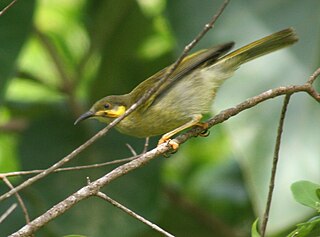
The Polynesian wattled honeyeater or the eastern wattled honeyeater, is a species of bird in the honeyeater family Meliphagidae. It was considered conspecific with the Fiji wattled honeyeater and the kikau.

The North Island kōkako is an endangered forest bird which is endemic to the North Island of New Zealand. It is grey in colour, with a small black mask. It has blue wattles. Because of its wattle, the bird is sometimes locally called the blue-wattled crow, although it is not a corvid.
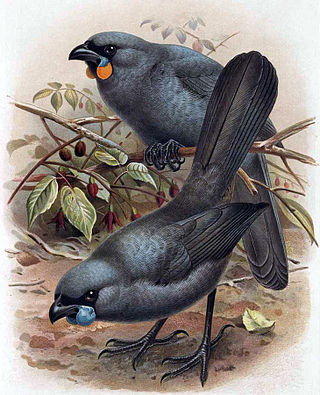
The South Island kōkako is a possibly extinct forest bird endemic to the South Island of New Zealand. Unlike its close relative, the North Island kōkako, it has largely orange wattles, with only a small patch of blue at the base, and was also known as the orange-wattled crow. The last accepted sighting in 2007 was the first considered genuine since 1967, although there have been several other unauthenticated reports.

The North Island saddleback is a forest-dwelling passerine bird species endemic to the North Island of New Zealand. It was once considered conspecific with the South Island saddleback. The IUCN lists the species as Near Threatened, while it is listed as a "recovering" species in the New Zealand Threat Classification System. Saddlebacks are known in Māori as tīeke.

The South Island saddleback or tīeke is a forest bird in the New Zealand wattlebird family which is endemic to the South Island of New Zealand. Both the North Island saddleback and this species were formerly considered conspecific. The Department of Conservation currently has the South Island saddleback listed as At Risk--Declining.
